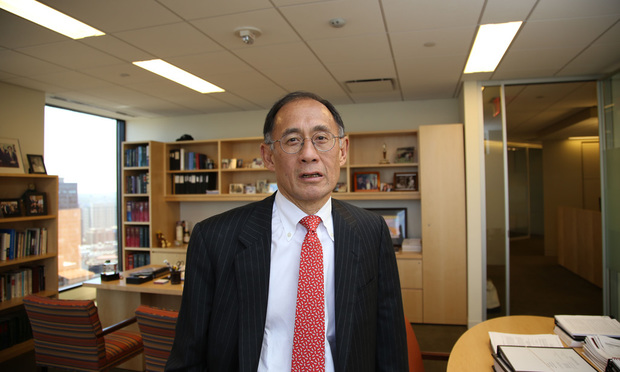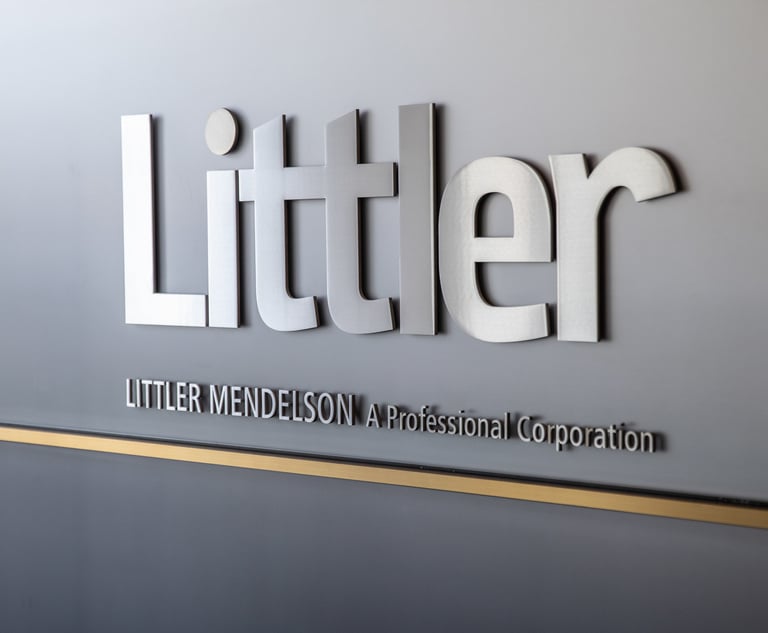Apple, Wilmer Knock Out $506 Million Patent Judgment
The Federal Circuit says no reasonable jury could have found the tech giant infringed a semiconductor patent developed at the University of Wisconsin.
September 28, 2018 at 05:08 PM
3 minute read
 William Lee of WilmerHale. May 2, 2013.
William Lee of WilmerHale. May 2, 2013.
Apple Inc. has escaped a $506 million patent infringement judgment over semiconductor technology.
The U.S. Court of Appeals for the Federal Circuit on Friday threw out the judgment won by the University of Wisconsin's technology transfer arm in a 2015 jury trial. “No reasonable juror could have found infringement based on the evidence presented during the liability phase of the trial,” Chief Judge Sharon Prost wrote for a unanimous panel.
The case has been fought tooth-and-nail at trial and on appeal by Wilmer Cutler Pickering Hale and Dorr for Apple and Irell & Manella for the university. Wilmer partner William Lee and Irell partner Morgan Chu squared off for a marathon one-hour-and-40-minute hearing in July before the Federal Circuit.
Wisconsin Alumni Research Foundation v. Apple involves data speculation circuits that help predict when to process instructions out of order and therefore more efficiently. University researchers helped pioneer the technology in the 1990s. The Wisconsin Alumni Research Foundation accused Apple's A7, A8 and A8X processors of infringing.
Irell and WARF settled similar claims against Intel for $110 million. Apple chose trial and got hit with a $234 million verdict in the Western District of Wisconsin. With royalties, supplemental damages, interest and costs the total came to $506 million. A second trial targeting a later generation of Apple's processors has been on hold pending the appeal.
U.S. Patent 5,781,752 describes a prediction table that communicates with a data speculation circuit to create an entry listing a “particular” load instruction associated with a mis-speculation. U.S. District Judge William Conley ruled at trial, and the Federal Circuit affirmed Friday, that “particular” means a single load instruction.
Apple argued that only 4,096 load tags are possible on its processor, so it uses a hashing algorithm to generate multiple load instructions for the same tag. “Each load tag can therefore be associated with a group of load instructions—namely, all of the load instructions that hash to the same load tag,” Prost wrote.
“Given that only 4,096 load tags are possible, and that Apple's operating system alone contains millions of load instructions, the only reasonable inference to draw is that load tags will always represent multiple load instructions,” Prost wrote. Therefore, the “particular” limitation of the '752 claim was not satisfied.
There was one silver lining for WARF. The Federal Circuit rejected Apple's challenge to the validity of the '752 patent.
Judges Kathleen O'Malley and William Bryson concurred in Prost's opinion.
This content has been archived. It is available through our partners, LexisNexis® and Bloomberg Law.
To view this content, please continue to their sites.
Not a Lexis Subscriber?
Subscribe Now
Not a Bloomberg Law Subscriber?
Subscribe Now
NOT FOR REPRINT
© 2025 ALM Global, LLC, All Rights Reserved. Request academic re-use from www.copyright.com. All other uses, submit a request to [email protected]. For more information visit Asset & Logo Licensing.
You Might Like
View All
US Judge Cannon Blocks DOJ From Releasing Final Report in Trump Documents Probe
3 minute read
Private Equity Giant KKR Refiles SDNY Countersuit in DOJ Premerger Filing Row
3 minute read
Three Akin Sports Lawyers Jump to Employment Firm Littler Mendelson
Trending Stories
- 1Departing Attorneys Sue Their Former Law Firm
- 2Pa. High Court: Concrete Proof Not Needed to Weigh Grounds for Preliminary Injunction Order
- 3'Something Else Is Coming': DOGE Established, but With Limited Scope
- 4Polsinelli Picks Up Corporate Health Care Partner From Greenberg Traurig in LA
- 5Kirkland Lands in Phila., but Rate Pressure May Limit the High-Flying Firm's Growth Prospects
Who Got The Work
J. Brugh Lower of Gibbons has entered an appearance for industrial equipment supplier Devco Corporation in a pending trademark infringement lawsuit. The suit, accusing the defendant of selling knock-off Graco products, was filed Dec. 18 in New Jersey District Court by Rivkin Radler on behalf of Graco Inc. and Graco Minnesota. The case, assigned to U.S. District Judge Zahid N. Quraishi, is 3:24-cv-11294, Graco Inc. et al v. Devco Corporation.
Who Got The Work
Rebecca Maller-Stein and Kent A. Yalowitz of Arnold & Porter Kaye Scholer have entered their appearances for Hanaco Venture Capital and its executives, Lior Prosor and David Frankel, in a pending securities lawsuit. The action, filed on Dec. 24 in New York Southern District Court by Zell, Aron & Co. on behalf of Goldeneye Advisors, accuses the defendants of negligently and fraudulently managing the plaintiff's $1 million investment. The case, assigned to U.S. District Judge Vernon S. Broderick, is 1:24-cv-09918, Goldeneye Advisors, LLC v. Hanaco Venture Capital, Ltd. et al.
Who Got The Work
Attorneys from A&O Shearman has stepped in as defense counsel for Toronto-Dominion Bank and other defendants in a pending securities class action. The suit, filed Dec. 11 in New York Southern District Court by Bleichmar Fonti & Auld, accuses the defendants of concealing the bank's 'pervasive' deficiencies in regards to its compliance with the Bank Secrecy Act and the quality of its anti-money laundering controls. The case, assigned to U.S. District Judge Arun Subramanian, is 1:24-cv-09445, Gonzalez v. The Toronto-Dominion Bank et al.
Who Got The Work
Crown Castle International, a Pennsylvania company providing shared communications infrastructure, has turned to Luke D. Wolf of Gordon Rees Scully Mansukhani to fend off a pending breach-of-contract lawsuit. The court action, filed Nov. 25 in Michigan Eastern District Court by Hooper Hathaway PC on behalf of The Town Residences LLC, accuses Crown Castle of failing to transfer approximately $30,000 in utility payments from T-Mobile in breach of a roof-top lease and assignment agreement. The case, assigned to U.S. District Judge Susan K. Declercq, is 2:24-cv-13131, The Town Residences LLC v. T-Mobile US, Inc. et al.
Who Got The Work
Wilfred P. Coronato and Daniel M. Schwartz of McCarter & English have stepped in as defense counsel to Electrolux Home Products Inc. in a pending product liability lawsuit. The court action, filed Nov. 26 in New York Eastern District Court by Poulos Lopiccolo PC and Nagel Rice LLP on behalf of David Stern, alleges that the defendant's refrigerators’ drawers and shelving repeatedly break and fall apart within months after purchase. The case, assigned to U.S. District Judge Joan M. Azrack, is 2:24-cv-08204, Stern v. Electrolux Home Products, Inc.
Featured Firms
Law Offices of Gary Martin Hays & Associates, P.C.
(470) 294-1674
Law Offices of Mark E. Salomone
(857) 444-6468
Smith & Hassler
(713) 739-1250











